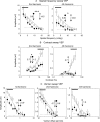Visuocortical function in infants with a history of neonatal jaundice
- PMID: 25183760
- PMCID: PMC4197714
- DOI: 10.1167/iovs.14-14261
Visuocortical function in infants with a history of neonatal jaundice
Abstract
Purpose: High concentrations of unconjugated bilirubin are neurotoxic and cause brain damage in newborn infants. However, the exact level of bilirubin that may be neurotoxic in a given infant is unknown. The aim of this study was to use a quantitative measure of neural activity, the swept parameter visual evoked potential (sVEP) to determine the relationship between neonatal bilirubin levels and visual responsivity several months later.
Methods: We compared sVEP response functions over a wide range of contrast, spatial frequency, and Vernier offset sizes in 16 full-term infants with high bilirubin levels (>10 mg/dL) and 18 age-matched infants with no visible neonatal jaundice, all enrolled at 14 to 22 weeks of age. The group means of sVEP thresholds and suprathreshold response amplitudes were compared. The correlation between individual sVEP thresholds and bilirubin levels in jaundiced infants was studied.
Results: Infants who had a history of neonatal jaundice showed lower response amplitudes (P < 0.05) and worse or immeasurable sVEP thresholds compared with control infants for all three measures (P < 0.05). Swept parameter visual evoked potential thresholds for Vernier offset were correlated with bilirubin level (P < 0.05), but spatial acuity and contrast sensitivity measures in the infants with neonatal jaundice were not (P > 0.05).
Conclusions: These results indicate that elevated neonatal bilirubin levels affect measures of visual function in infancy up to at least 14 to 22 weeks of postnatal age.
Keywords: Vernier acuity; contrast sensitivity; hyperbilirubinemia; jaundice; spatial frequency; swept parameter visual evoked potentials.
Copyright 2014 The Association for Research in Vision and Ophthalmology, Inc.
Figures


References
-
- Maisels MJ. What's in a name? Physiologic and pathologic jaundice: the conundrum of defining normal bilirubin levels in the newborn. Pediatrics. 2006; 118: 805–807 - PubMed
-
- Perlstein M. Neurologic sequelae of erythroblastosis fetalis. Am J Dis Child. 1950; 79: 605–606
-
- Practice parameter: management of hyperbilirubinemia in the healthy term newborn. American Academy of Pediatrics. Provisional Committee for Quality Improvement and Subcommittee on Hyperbilirubinemia. Pediatrics. 1994; 94 (pt 1): 558–565 - PubMed
-
- Newman TB, Liljestrand P, Jeremy RJ, et al. Outcomes among newborns with total serum bilirubin levels of 25 mg per deciliter or more. N Engl J Med. 2006; 354: 1889–1900 - PubMed
-
- American Academy of Pediatrics Subcommittee on Hyperbilirubinemia. Management of hyperbilirubinemia in the newborn infant 35 or more weeks of gestation. Pediatrics. 2004; 114: 297–316 - PubMed
Publication types
MeSH terms
Substances
Grants and funding
LinkOut - more resources
Full Text Sources
Other Literature Sources

